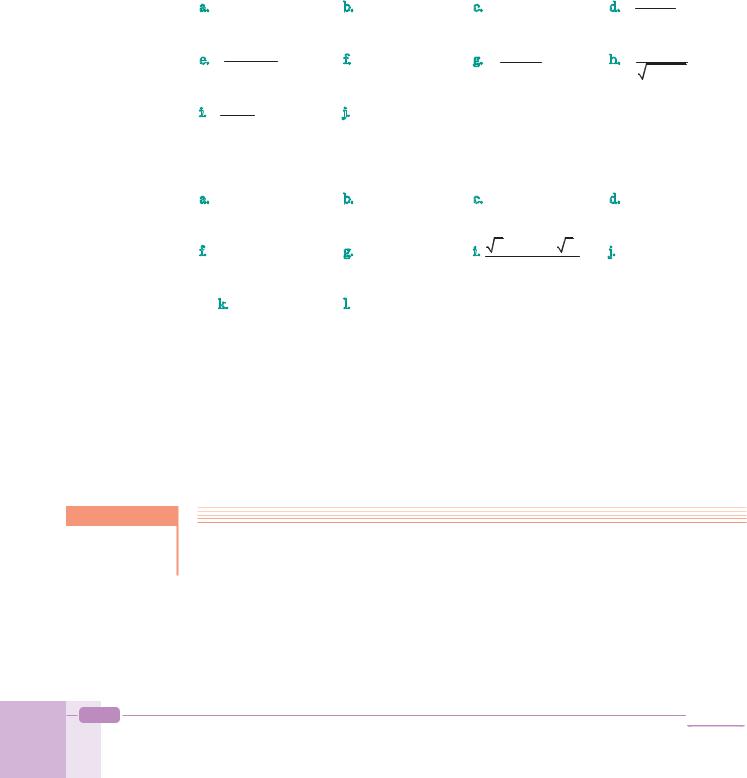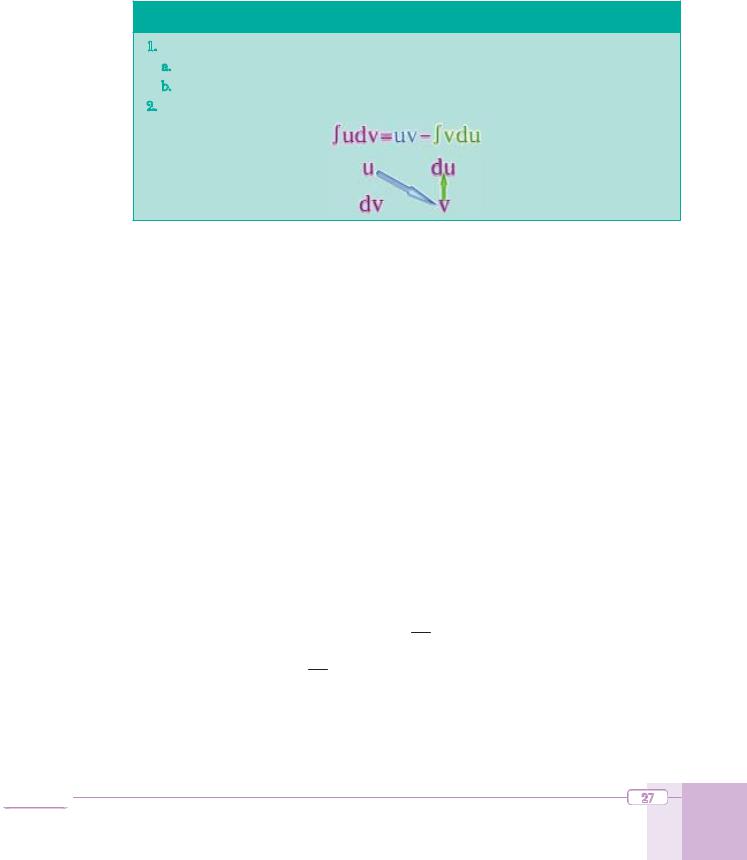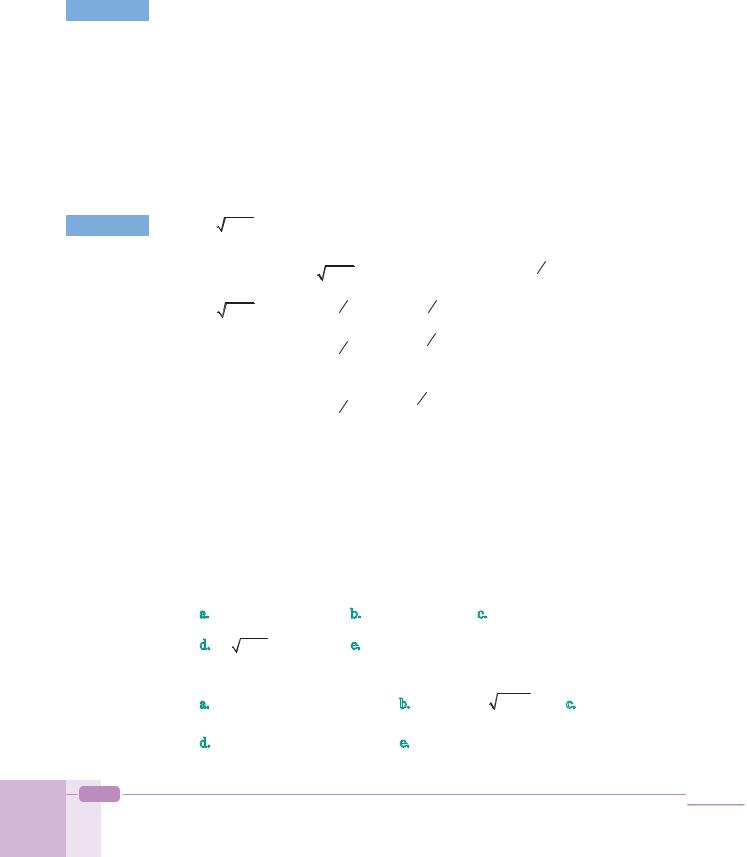
11 ALGEBRA
.pdf
EXAMPLE 24 3tan2(2x+1) dx= ?
Solution 3tan2(2x 1) |
dx= 3 tan2(2 x 1) dx |
|
= 3 (1 tan2(2x 1) 1) dx |
|
= 3( 1 tan(2x+1) – x)+ c |
|
2 |
|
= 3 tan(2x+1) 3x+ c |
|
2 |
Check Yourself 3
Evaluate the integrals.
a. (sin x cos x)2 dx
|
|
1 |
|
+ |
1 |
|
dx |
||
d. |
|
2 |
x |
sin |
2 |
|
|||
|
cos |
|
|
|
x |
|
|||
g. tan2 2x |
|
|
|
|
|
||||
j. |
5 |
|
|
dx |
|
|
|
|
|
1+ x |
2 |
|
|
|
|
|
|||
|
|
|
|
|
|
|
|
|
|
Answers
a. x 21 cos2x+ c
d. tan x – cot x + c
g. tan2x x+ c 2
j. 5arctan x + c
b. 2sin x 3cos x |
c. |
3 |
dx |
|
4 4x2 |
||||
e. sin4x dx |
f. |
cos(5x 1) dx |
||
h. cot2(3x+1) dx |
i. |
sin2 x dx |
|
|
b. –2cos x – 3sin x + c |
c. |
3 arcsin x+ c |
|
||
|
|
|
2 |
|
|
e. 1 cos4x+ c |
|
f. |
1 sin(5x 1)+ c |
||
4 |
|
|
5 |
|
|
h. cot(3x+1) |
x+ c |
i. |
x |
sin xcos x |
+ c |
3 |
|
|
2 |
2 |
|
Integrals |
19 |

Sir Isaac Newton (1642-1727)
Sir Isaac Newton is one of the greatest mathematicians in the history of mathematics.
Isaac was born in England in 1642. His father was a farmer but he died before Isaac was born. Isaac’s mother remarried when Isaac was two years old and left Isaac in the care of his grandmother. Isaac went to Trinity College, Cambridge in 1661.
At Cambridge, Isaac want to be a lawyer, but first studied philosophy. However, when he learned about the work of Descartes in algebra and analytic geometry he decided to study mathematics and mechanics. He
studied mathematics and physics until the University closed in 1665 because of the plague. Then he went home to Lincolnshire for two years.
While Isaac was at home he studied mathematics, optics, physics and astronomy. In this period of two years he established the beginnings of differential and integral calculus, independently of from the discoveries of another mathematician, Leibniz. He also made discoveries concerning the area of the region under a curve, the tangent of a curve at a point, and the maxima, minima and arc lengths of curves.
In 1669, at the age of twenty-seven, Isaac returned to Cambridge University and became a professor of mathematics. Then he studied optics. In 1672 he was elected to the Royal Society.
Newton’s greatest works were about physics, mechanics and optics. He also discovered the rules of gravity, and made important discoveries in calculus.
Newton wrote his most famous book, the Principia Mathematica, in 1687. In the Principia, Newton described his work in physics and its applications in astronomy and mathematics. Some people today consider the Principia to be one of the greatest science books ever written.
In 1693, Newton suffered a nervous breakdown so he stopped his research and took up a government position in London. In 1703 he was elected President of the Royal Society. In 1708, Queen Anne knighted Newton, and he became Sir Isaac Newton. He was the first scientist to be so honored.
Isaac Newton died on 31 March 1727 in London.

B. INTEGRATION METHODS
We have seen how to use basic integral formulas and properties to find the integral of different functions. However, for some questions, using just these rules will not be enough to find the integral.
In this section, we will look at other methods we can use to integrate a function. These are: integration by substitution,
integration by parts,
and special methods for the integration of rational, radical and trigonometric functions.
1. Integration by Substitution
For some integral problems, using x as variable does not give an expression that we can integrate easily. In this situation we can choose to change the variable. This method is called the substitution method of integration. The following theorem states the formula we use in the substitution method.
Theorem
Let F(u) and u(x) be two functions which are differentiable with respect to u and x respectively. Then
f (u(x)) u (x) dx = F(u(x))+ c.
Proof We know from the Chain Rule that when F (x) = f(x) then dF(u(x)) = F '(u(x)) u'(x). dx
Integrating both sides of this equation with respect to x gives us:
dF(u(x)) dx = f (u(x)) u'(x) dx. dx
This implies F(u(x)) + c = f (u(x)) u (x) dx, which completes the proof.
In practical terms, we can summarize the substitution method of integration as follows:
SUBSTITUTION METHOD
1.Decide which term to substitute (i.e. select u = g(x)).
2.Differentiate both sides of u = g(x) to get dudx g (x).
3.Rewrite the result as du = g (x) dx.
4.Make these substitutions in the original integral to get a simpler expression.
5.Integrate the simpler expression, then substitute back the original terms using u = g(x).
Integrals |
21 |

EXAMPLE 25 (x 1)2 dx =?
Solution 1
Solution 2
By using basic integration formula 1a we can get the answer:
(x 1)2 dx = (x2 2x 1) dx= x3 x2 + x+ c1. 3
We can use the substitution method:
Let u = x – 1, then du = dx. Then (x 1)2 dx= u2 du = u3 + c2. 3
Now substitute back u = x – 1:
(x 1)3 + c = x3 3x2 +3x 1 |
+ c = x3 |
x2 + x |
1 + c . |
||||
3 |
2 |
3 |
2 |
3 |
|
3 |
2 |
|
|
|
|
||||
We now have 13 + c2 instead of c1 but we can say the answers are the same. Can you see why?
Note
Any substitution will not work correctly in this method. An ideal substitution is the one that
1.removes all old variables,
2.makes the integral expression simpler.
|
26 (1 x)9 dx =? |
|
|
|
EXAMPLE |
|
|
|
|
|
|
|
|
|
Solution Let u = 1 – x, then du = –dx. Substitute this in the question: |
||||
|
(1– x)9 dx= u9 (– du)= – u9 du= – u10 |
+ c= – |
(1– x)10 |
+ c. |
|
10 |
|
10 |
|
|
27 3x2 cos x3dx =? |
|
|
|
EXAMPLE |
|
|
|
|
|
|
|
|
|
Solution Let u = x3, then du = 3x2 dx. Substituting these gives:3x2 cos x3 dx = cos u du = sin u+ c= sin x3 + c.
EXAMPLE 28 (x2 +5)7 x dx =?
Solution Let u = x2 + 5, then du = 2x dx, i.e. du2 = x dx.
Substituting these gives:
(x2 +5)7 x dx = |
1 |
u7du = |
1 |
|
u8 |
+ c = |
(x2 +5)8 |
+ c. |
|
2 |
|
2 |
|
8 |
|
16 |
|
22 |
Algebra 11 |

|
29 |
(2x2 +1)(2x3 +3x)7 dx =? |
|
|
|
|
|
|
|
|
|
EXAMPLE |
|
|
|
|
|
|
|
|
|
||
|
|
|
|
|
du |
|
|
|
|
||
Solution |
Let u = 2x3 + 3x, then du = (6x2 + 3 ) dx, i.e. |
= (2x2 |
+ 1) dx. So |
||||||||
|
|
|
|
|
|
|
3 |
|
|
|
|
|
|
(2x2 +1)(2x3 +3x)7 dx= u7 |
du = |
1 u7 |
du= |
1 u8 |
+ c= |
(2x3 +3x)8 |
+ c. |
||
|
|
|
3 |
3 |
|
3 8 |
|
|
24 |
|
|
|
30 |
f 5(x) f '(x) dx =? |
|
|
|
|
|
|
|
|
|
EXAMPLE |
|
|
|
|
|
|
|
|
|
||
|
|
|
|
|
|
|
|
|
|
||
Solution |
Let u = f(x), then du = f (x) dx. So |
|
|
|
|
|
|
|
|
||
|
|
f 5(x) f '(x) dx = u5 du = u6 |
+ c = |
|
f 6 (x) |
+ c. |
|
|
|
|
|
|
|
6 |
|
|
|
|
|
||||
|
|
6 |
|
|
|
|
|
|
|
||
EXAMPLE 31 1 3x dx =?
Solution Let u = 1 – 3x, then du = –3 dx, i.e. dx = du . |
|||||||
|
|
|
|
|
|
|
3 |
So |
1 3x dx = |
u ( du) |
|
|
|
|
|
|
|
|
3 |
|
|
|
|
|
= |
1 |
u12 du = |
1 |
|
u32 |
+ c |
|
3 |
3 |
|
||||
|
|
|
3 |
|
|||
|
|
|
|
|
2 |
|
|
|
= |
2 |
(1 3x)32 + c. |
|
|
|
|
|
|
9 |
|
|
|
|
|
EXAMPLE 32 sin3 x cos x dx =?
Solution Let u = sin x, then du = cos x dx. So
sin3 x cos x dx = u3 du = u4 + c = sin4 x+ c.
4 4
Integrals |
23 |

|
33 |
cos3 x dx =? |
|
|
|
|
|
|
|
|
|
|
|
|
||||||||
EXAMPLE |
|
|
|
|
|
|
|
|
|
|
|
|
||||||||||
|
|
|
|
|
|
|
|
|
|
|
|
|
||||||||||
Solution |
Let u = sin x, then du = cos x dx. So |
|
||||||||||||||||||||
|
|
cos3 x dx = cos2 x cos x dx |
|
|
|
|
|
|||||||||||||||
|
|
|
|
|
|
|
|
|
|
= (1 sin2 x)cos x dx |
|
|
|
|||||||||
|
|
|
|
|
|
|
|
|
|
= (1 u2 ) du |
|
|
|
|
|
|
||||||
|
|
|
|
|
|
|
|
|
|
= u |
u3 |
+ c |
|
|
|
|
|
|
|
|||
|
|
|
|
|
|
|
|
|
|
3 |
|
|
|
|
|
|
|
|||||
|
|
|
|
|
|
|
|
|
|
|
|
|
|
|
|
|
|
|
|
|
|
|
|
|
|
|
|
|
|
|
|
|
= sin x |
sin3 |
x |
+ c. |
|
|
|
|
|
||||
|
|
|
|
|
|
|
|
|
|
|
|
3 |
|
|
|
|
|
|
||||
|
|
|
|
|
|
|
|
|
|
|
|
|
|
|
|
|
|
|
|
|
|
|
|
34 |
|
|
|
1 |
|
|
|
|
|
|
|
|
|
|
|
|
|
|
|
|
|
EXAMPLE |
|
|
|
|
|
|
dx =? |
|
|
|
|
|
|
|
|
|
|
|
||||
|
|
|
|
|
|
|
|
|
|
|
|
|
|
|
|
|
|
|||||
|
|
1 |
9x |
2 |
|
|
|
|
|
|
|
|
|
|
|
|||||||
|
|
|
|
|
|
|
|
|
|
|
|
|
|
|
|
|
|
|
||||
Solution |
Let u = 3x, then du = 3 dx, i.e. dx = du . Substituting gives: |
|||||||||||||||||||||
|
|
|
|
|
|
|
|
|
|
|
|
|
|
|
|
|
|
|
|
|
3 |
|
|
|
|
|
|
|
1 |
|
|
|
dx = |
|
|
1 |
|
du |
|
|
|
|
|
||
|
|
|
|
|
|
|
|
|
|
|
|
|
|
3 |
|
|
|
|
|
|||
|
|
|
|
|
|
|
|
|
|
|
|
|
|
|
|
|
|
|
||||
|
|
|
|
|
1 |
9x2 |
|
1 u2 |
|
|
|
|
|
|
||||||||
|
|
|
|
|
|
|
|
|
= |
1 arcsin u+ c |
|
1arcsin3x+ c |
||||||||||
|
|
|
|
|
|
|
|
|
|
|
3 |
|
|
|
|
1 |
|
3 |
|
|
1 |
|
|
|
|
|
|
|
|
|
|
|
|
|
|
|
|
|
|
|
|
|
|||
|
|
|
|
|
|
|
|
|
|
or |
|
|
|
|
|
|
|
|
|
|
|
|
|
|
|
|
|
|
|
|
|
= |
1 arccos u+ c |
= |
|
1arccos3x+ c . |
|||||||||
|
|
|
|
|
|
|
|
|
|
|
|
3 |
|
|
|
|
|
2 |
|
|
3 |
2 |
|
|
|
|
|
|
|
|
|
|
|
|
|
|
|
|
|
|
|
|
|
||
|
35 |
|
|
1 |
|
|
|
|
|
|
|
|
|
|
|
|
|
|
|
|
||
EXAMPLE |
|
|
|
|
dx =? |
|
|
|
|
|
|
|
|
|
|
|
||||||
|
|
|
|
|
|
|
|
|
|
|
|
|
||||||||||
1+4x2 |
|
|
|
|
|
|
|
|
|
= du |
|
|||||||||||
|
|
|
|
|
|
|
|
|
|
|
|
|
|
|||||||||
Solution Let u = 2x, then du = 2 dx, i.e. dx |
. So |
|||||||||||||||||||||
|
|
|
|
|
|
|
|
|
|
|
|
|
|
|
|
|
|
|
|
|
2 |
|
|
|
|
|
|
|
1 |
|
|
dx = |
|
1 |
|
|
du |
|
|
|
|
|
|
||
|
|
|
|
|
|
|
|
|
|
|
|
|
|
|
|
|
|
|
|
|||
|
|
1 |
|
4x |
2 |
|
1 u |
2 |
2 |
|
|
|
|
|
|
|
||||||
|
|
|
|
|
|
|
|
|
|
|
|
|
|
|
||||||||
|
|
|
|
|
|
|
|
|
|
= 1 arctan u+ c = |
1 arctan2 x+ c |
|||||||||||
|
|
|
|
|
|
|
|
|
2 |
|
|
|
|
|
1 |
|
2 |
|
|
1 |
||
|
|
|
|
|
|
|
|
|
|
|
|
|
|
|
|
|
|
|
||||
|
|
|
|
|
|
|
|
|
|
or |
|
|
|
|
|
|
|
|
|
|
|
|
|
|
|
|
|
|
|
|
|
|
= 1 arccot u+ c |
= |
1arccot 2 x+ c . |
||||||||||
|
|
|
|
|
|
|
|
|
|
|
2 |
|
|
|
|
2 |
|
|
2 |
|
2 |
|
|
|
|
|
|
|
|
|
|
|
|
|
|
|
|
|
|
|
|
|
|||
Fundamental
Trigonometric Identity:
sin2 x + cos2 x = 1
24 |
Algebra 11 |

EXAMPLE 36 (x+2)(x 1)4 dx =?
Solution In this problem, we cannot immediately get the answer using one substitution. Let us find a substitution for each term instead.
Let u = x – 1 so du = dx.
Now we can write x = u+1, so x+2 = u + 3. Now we can substitute:
|
|
(x+2)(x 1)4 dx = (u+3) u4 du |
|
||||||
|
|
|
|
= (u5 +3u4 ) du |
|
||||
|
|
|
|
= |
u6 |
+3 |
u5 |
+ c |
|
|
|
|
|
6 |
5 |
|
|||
|
|
|
|
|
|
|
|
||
|
|
|
|
= |
(x 1)6 |
+ |
3(x 1)5 |
+ c. |
|
|
|
|
|
|
|
6 |
|
5 |
|
|
37 |
7 |
|
|
|
|
|
|
|
|
|
|
|
|
|
|
|||
EXAMPLE |
|
|
dx =? |
|
|
|
|
|
|
(5x+2)9 |
|
|
|
|
|
||||
|
|
|
|
|
|
|
|||
Solution Let u = 5x+2, then du = 5 dx, i.e. dx = du5 .
So |
7 |
|
dx = |
|
|
|
7 |
du |
|
|
|
9 |
|
|
9 |
|
|||||
|
(5x+2) |
|
5u |
|
|
|
||||
|
|
= |
7 |
|
u 9 du |
|
||||
|
|
|
|
5 |
|
|
|
|
|
|
|
|
= |
7 |
|
|
u 8 |
+ c |
|
||
|
|
5 |
|
8 |
|
|||||
|
|
|
|
|
|
|
|
|||
|
|
|
= |
|
|
7 |
|
+ c |
|
|
|
|
|
|
40u8 |
|
|||||
|
|
|
|
|
|
|
|
|||
|
|
|
= |
|
|
|
|
7 |
c. |
|
|
|
|
|
40(5x+2)8 |
||||||
Integrals |
25 |

Check Yourself 4
Evaluate the integrals.
a. sin(1 x) dx |
b. (1 x3 )5 |
x2 dx |
c. x sin(5x2 1) dx |
d. |
1 |
5 |
2 dx |
||||||
|
|
|
|
|
|
|
|
|
|
9x |
|
|
|
sin x |
|
|
|
|
|
1 |
|
|
|
|
3 |
|
|
e. 1 cos2 x dx |
f. sin(7x 1) dx |
g. |
1+2x2 |
dx |
h. |
|
|
1 4x2 |
dx |
||||
x |
j. sin xcos |
3 |
|
|
|
|
|
|
|
|
|
|
|
i. 1+ x4 dx |
|
x dx |
|
|
|
|
|
|
|
|
|
||
Answers |
|
|
|
|
|
|
|
|
|
|
|
|
|
a. cos (x – 1) + c |
b. |
(x3 1)6 |
+ c |
c. cos(5x2 |
1) + c |
d. |
5arctan3x + c |
||||||
|
|
18 |
|
|
|
10 |
|
|
|
|
3 |
|
|
f. –arctan(cos x) + c |
g. |
1 cos(7x+1)+ c |
i. |
2 arctan( x 2) + c |
j. |
3arcsin2x |
+ c |
||||||
|
|
7 |
|
|
|
2 |
|
|
|
|
2 |
|
|
k. arctan x2 + c |
l. cos4 x + c |
|
|
|
|
|
|
|
|
|
|||
2 |
|
4 |
|
|
|
|
|
|
|
|
|
|
|
2. Integration by Parts
Integration by parts is the second main method of integration. Many of the other methods of integration use integration by parts, so it is an important method to master.
Integration by parts is a method for evaluating integrals of the form f (x) g(x) dx which are difficult to evaluate using other techniques. The method uses the following theorem:
Theorem
Let u = f(x) and v = g(x) be two differentiable functions with respect to x, then
u v dx = u v v u dx.
Proof We know from differentiation that d(u v) = v du + u dv.
If we take the integral of both sides we get d(u v)= v du + u dv, which gives u v = v du+ u dv.
Rearranging gives u dv = u v – v du, which is the required result.
26 |
Algebra 11 |

SUBSTITUTION METHOD
1.Express the integrand as a product of two expressions such that
a.one of them is easy to differentiate (u)
b.the other is easy to integrate (dv).
2.Use the below scheme to rewrite the integral.
|
|
Note |
|
|
|
|
|
|
|
|
|
In this part we use u and v instead of du and dv to make expressions shorter. |
|||||||
|
|
Note |
|
|
|
|
|
|
|
|
|
In this method there is no rule for the selection of u and v but generally we choose u to be |
|||||||
|
|
the function whose degree reduces when we take its derivative. Typically, we often choose |
|||||||
|
|
logarithmic and inverse trigonometric functions for u, and functions such as ex, sin x, cos x |
|||||||
|
|
etc. for v , although these are only guidelines. |
|||||||
|
38 x cos x dx =? |
|
|
|
|
|
|
|
|
EXAMPLE |
|
|
|
|
|
|
|
||
|
|
|
|
|
|
|
|
||
Solution |
Let u = x and v = cos x, then u =1 and v = sin x. |
||||||||
|
|
So x cos x dx x sin x sin x dx = x sin x+cos x+ c. |
|||||||
|
39 arctan x dx =? |
|
|
|
|
|
|
|
|
EXAMPLE |
|
|
|
|
|
|
|
||
|
|
|
|
1 |
|
||||
Solution |
Let u = arctan x and v = 1, then u |
|
|||||||
= |
|
and v = x. |
|||||||
1+ x2 |
|||||||||
|
|
So arctan x dx = x arctan x |
|
|
x |
|
dx. We can now use integration by substitution: |
||
|
|
|
|
|
|
||||
|
|
1 |
x |
2 |
|||||
|
|
|
|
|
|
|
|||
Let w = 1+ x2, then dw = 2x dx and x dx = dw2 . This gives
arctan x dx= x arctan x 21w dw
=x arctan x 21 ln| w|+c
=x arctan x 21 ln(1+ x2 )+ c.
Integrals |
27 |

EXAMPLE 40 x sin4x dx =?
Solution
EXAMPLE 41
Let u = x and v = sin 4x, then u = 1 and |
v = |
1 cos4x. |
|||
|
|
|
|
|
4 |
x sin4x dx = x cos4x |
– cos4x |
dx |
|
|
|
|
4 |
4 |
|
|
|
|
= x cos4x |
+ 1 cos4x dx |
|
|
|
|
4 |
4 |
|
|
|
|
= x cos4x |
+ sin4x + c |
|
|
|
|
4 |
16 |
|
|
|
x |
x 2 dx =? |
|
|
|
|
Solution Let u = x and v = |
x 2, then u = 1 and |
v = |
2 |
(x 2)32. |
This gives |
|
|
|
3 |
|
|
x x 2 dx = |
2 |
(x 2)32 x – |
|
2 |
(x 2)32 |
dx |
|
|
3 |
|
|
3 |
|
|
|
= |
2 |
(x 2)32 x – |
2 |
|
(x 2)52 |
+ c |
|
|
3 |
|
3 |
|
5 |
|
|
|
|
|
|
|
2 |
|
|
= |
2 |
(x 2)32 x – |
4(x 2)52 |
+ c. |
|||
|
3 |
|
|
|
15 |
|
|
Note
When we integrate a function, we may get two different answers if we use two different methods. However, if our working is correct for each method then we say that both of the solutions are correct. This is because the integral is the antiderivative, and there may be two or more functions with the same derivative.
Check Yourself 5
Evaluate the integrals.
a. x2 |
sin x dx |
|
b. |
arcsin x dx |
c. |
(2x 1)sin3x dx |
|
|
|
|||||
d. x |
x+1 dx |
|
e. |
3x sin x cos x dx |
|
|
|
|
|
|
|
|
||
Answers |
|
|
|
|
|
|
|
|
|
2sin3x |
|
(2x 1)cos3x |
|
|
a. (2 – x2) cos x + 2x sin x + c b. |
xarcsin x+ |
1 x2 + c |
|
c. |
|
+ c |
||||||||
|
|
|
|
|
|
|
|
|
|
|
9 |
|
3 |
|
d. 2(x+1)3 / 2(3x 2) |
+ c |
|
e. |
3sin xcos x |
+ |
3xsin2 x |
|
3x |
+ c |
|
|
|
||
|
15 |
|
|
|
4 |
2 |
4 |
|
|
|
||||
28 |
Algebra 11 |
